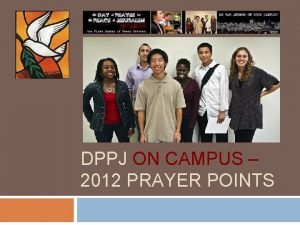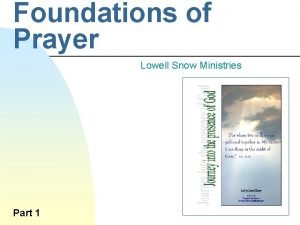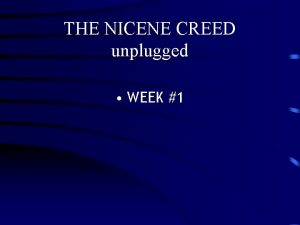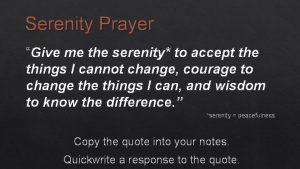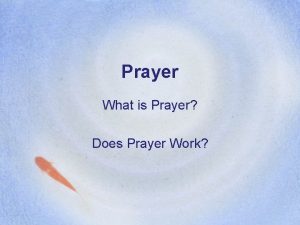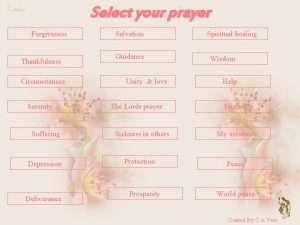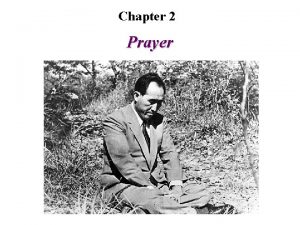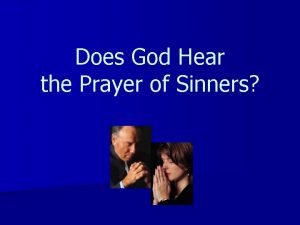THE SERENITY PRAYER God grant me the serenity



























- Slides: 27

THE SERENITY PRAYER “God, grant me the serenity to accept the things I cannot change, the courage to change things I can, and the wisdom to know the difference. ” Reinhold Niebuhr

Class Conduct: 40 -10 -40 Questions Opinions We will discuss and hopefully clarify the reading for the week. • Please try to bring the book to class; it will help you follow the discussion. • •

Class Conduct: • Materials from other books by Seligman and others. • You will also have the opportunity to take selfassessment surveys, evaluated only by you and confidential. • Something to write with and on • Folder

Two ways to take the class… • Read the book and listen in class – academic exercise. That is good. • Participate and try some relevant interventions and see if they work for you. That is better. – These activities will help you understand Positive Psychology and perhaps will increase your Well. Being.

Flourish - Martin Seligman • Positive Psychology; how to go from plus two to plus seven. • Research Based – Internal, External Validity – Correlation and Causation – Random Assignment Placebo-Controlled – Not 100% Predicable

Positive Psychology • Well-Being • Optimism

Well-Being • • • Positive Emotion Engagement – a. k. a. Flow Relationships Meaning Accomplishment Pursued For-its-own-sake

Optimism • Inherited • Can be developed • Used in a flexible, planned manner

Benefits • Prevent PTSD • Reduce the incidence of CVD • Reduce the incidence of infectious diseases • Lead to a longer and fuller lifespan

Introduction 1. Monism verses Pluralism 2. Experimental Realism 3. Correlation and Causation.

1. Philosophical Topic • Monism – Reduces all human motives to one – Everything has a singular cause • Pluralism – Many factors can motivate behavior

Psychological Experiments • Individuals differ • What most people do most of the time under a given set of circumstances • Conclusions may not be precise for all people

2. Realism • Experimental Realism – The experiment feels real to the subjects even though they never have the same experience in daily life. • Mundane Realism – The experiment is similar to events in the outside world

Learned Helplessness • Mid 1960 s • Nothing you do will alter events • Relevant factor in anxiety and depression

Learned Helplessness • TRIADIC DESIGN • Subjects are divided into three groups – One group (ESCAPABLE) is exposed to a noxious event that they can escape – One group (INESCAPABLE) is exposed to the same event but can’t make it stop no matter what they do – A third group is the CONTROL group.

Part 1 • ESCAPABLE and INESCAPABLE groups are exposed to the same noxious event • ESCAPABLE learn that what they do can make a difference • INESCAPABLE learn they are helpless. • CONTROL group does not participate in Part 1.

Part 2 • All three groups participate • “shuttle box” – The subject puts their hand in one side of a box; then a loud noise sounds. – If the subject moves his hand a few inches to the other side, the noise goes off.

Learned Helplessness • ESCAPABLE group and the CONTROL group readily learn to move their hand to escape the noise. • INESCAPABLE group typically do not move. – They learned in Part 1 that what they do doesn’t matter, – So in Part 2 they do not try to escape.

TRIADIC DESIGN • ESCAPABLE, INESCAPABLE, and CONTROL • Bi-directional inferences – Does helplessness damage a person? – Do the inescapable do worse than the control group? – Does mastery strengthen a person? – Do the escapable subjects perform better than the control group?

Learned Helplessness • About one-third of the subjects, both animal and human never became helpless! • About one-tenth were helpless to begin with. • Led to the exploration of Optimism/Pessimism and their relation to Learned Helplessness

Optimism • Helplessness (1975) – Little is made of the resistant and already helpless subjects – Makes no mention of Optimism

Psychological Experiments • All subjects did not behave the same way • Resulting experimental realism was of value

CORRELATION ≠ CAUSATION • CORRELATION – Either when one goes up the other almost ALWAYS goes up – Or when one goes up the other almost ALWAYS goes down

CORRELATION ≠ CAUSATION • Strong Positive Correlation: – Church Attendance – Consumption of Alcohol • Does one cause the other? • Is there a third variable causing both?

CORRELATION ≠ CAUSATION • Population is a common factor that causes both… • Attempt to eliminate possible third variables • To establish what appears to be a plausible causal relationship. • The reason for random assignments to groups

PLEASE… • • BRING YOUR BOOK TO CLASS SOMETHING TO WRITE WITH SOMETHING TO WRITE ON SOME KIND OF FOLDER

THE SENILITY PRAYER Grant me the senility to forget the people I never liked anyway, the good fortune to run into the ones I do, and the eyesight to tell the difference.
 Bayimu
Bayimu God grant me the senility
God grant me the senility Prayer for justice and peace
Prayer for justice and peace Prayer topics for prayer meeting
Prayer topics for prayer meeting Most merciful god we confess
Most merciful god we confess Prayer guide: a manual for leading prayer lowell snow
Prayer guide: a manual for leading prayer lowell snow Keep on believing god will answer prayer hymn lyrics
Keep on believing god will answer prayer hymn lyrics Gracious and merciful god
Gracious and merciful god Prayer to mary mother of god
Prayer to mary mother of god In the name of god most gracious prayer
In the name of god most gracious prayer I confess to almighty god prayer
I confess to almighty god prayer I believe in god prayer new version
I believe in god prayer new version Loving father prayer
Loving father prayer Lamb of god prayer
Lamb of god prayer Apostles creed methodist
Apostles creed methodist Keep on believing god will answer prayer hymn lyrics
Keep on believing god will answer prayer hymn lyrics Prayers for an exam
Prayers for an exam Full armor of god prayer
Full armor of god prayer Prayer is the raising of the heart and mind to god
Prayer is the raising of the heart and mind to god Be present at our table lord
Be present at our table lord I confess to almighty god prayer
I confess to almighty god prayer How great is our god prayer
How great is our god prayer In the name of god most gracious prayer
In the name of god most gracious prayer Prayer nuggets
Prayer nuggets Oh god our heavenly father prayer
Oh god our heavenly father prayer Keep on believing god will answer prayer hymn lyrics
Keep on believing god will answer prayer hymn lyrics Oh most high and glorious god
Oh most high and glorious god Bless us o lord as we sit together
Bless us o lord as we sit together



